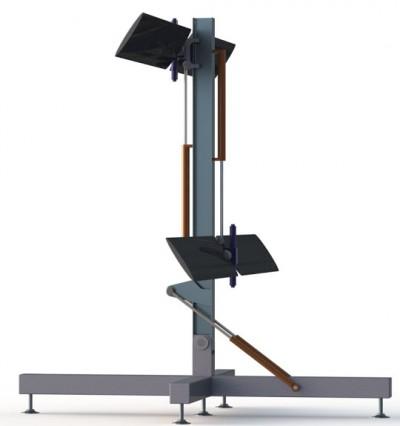 Mounted on the sea floor, the device’s wings move up and down the stationary pole,
Mounted on the sea floor, the device’s wings move up and down the stationary pole, generating power. More wings can be added, and the device can fold flat to allow
large ships or loaded barges to pass safely. (Credit: Mandre lab / Brown University)
A research group at Brown is designing a device to gather tidal energy in shallow water, where the ebb and flow move fastest and the energy potential is highest.
Led by Shreyas Mandre, assistant professor of engineering, the group is developing a hydrofoil—a water wing—as a means to harvest tidal energy. Unlike other tidal energy technologies, the wing is a shallow water specialist.
With support from the Advanced Research Projects Agency-Energy (ARPA-E), the group has designed a small water wing prototype has been testing in the lab to prove the concept. Late last month, they presented their preliminary results at the ARPA-E Energy Innovation Summit in Washington, D.C., and at The Bicameral Task Force on Climate Change, organized by Sen. Sheldon Whitehouse (D-R.I.) and Rep. Henry Waxman (D-Calif.).
“We were very encouraged by the response we received,” Mandre said. “We’re looking forward to getting to work on the next phase of the project.”
The group’s work grew partly out of a recent study commissioned by the Department of Energy to identify the best locations for harvesting tidal energy. The study found that many ideal locations are in shallow bays and inlets, often 10 meters in depth or less.
“When [tidewater] is forced through a narrow, shallow channel it speeds up, and therefore focuses the energy,” Mandre said. “It’s this focusing we want to take advantage of.”
But harvesting energy from the shallows comes with a myriad of problems—especially for traditional, windmill-style turbines. The circular motion of a turbine means it must be as tall as it is wide, a geometry ill-suited for a channel that is wide but shallow like many of those identified in the DOE report.
And that’s not the only problem. Bays and inlets are often shipping channels and recreation areas, so tall turbines could get in the way of commercial and recreational boats. There are also concerns about fish and other wildlife swimming among spinning blades.
A water wing device offers a different approach. It catches the energy of tidal flows in much the same way that an airplane wing catches air. In the design Mandre and his team are developing, a wing is attached to a central pole on which it moves up and down. At the bottom of the stroke, the water wing is oriented in a way that causes the water to push it upward. At the top of the stroke, the orientation pushes the wing back down. The up and down motion is used to power a generator.
The beauty of the design is that it is a good geometric fit in wide and shallow channels. A single wing can span an area that would require a series of several turbines placed side-by-side—an expensive and inefficient arrangement. Gaps between the turbines would allow water to slip through untouched, which is a waste of potential power. A wide wing, on the other hand, could generate power from the entire span.

The hydrofoil team presents findings in Washington, D.C.
From left: Jennifer Franck, lecturer in engineering; Michael James Miller, grad student; Kenneth Breuer, professor of engineering; Shreyas Mandre, professor of engineering and team leader; Benjamin Strom, research engineer; and Bryan Willson, a program director at the Advanced Research Projects Agency-Energy (ARPA-E). (Credit: Brown University)
Concerns about shipping traffic and wildlife are lessened by the wing design as well. The apparatus can lie flat on the sea floor when big ships come through. The oscillating motion is biomimetic—not unlike a flapping fin—and less violent than a turbine spinning like a lawnmower blade.
The hydrofoil concept itself isn’t entirely new, Mandre says. But his team’s design adds a crucial new wrinkle—a “secret sauce,” as he puts it.
That sauce is a computer algorithm that monitors and controls the fine motion of the water wing for maximum efficiency.
“It tries a certain stroke and measures the power output. Then it tries a neighboring stroke and measures the power from that. If the new stroke works better, it moves to that stroke,” Mandre said. “The tidal currents are constantly changing, so this lets us search constantly to find the best movement.”
Mandre and his colleagues have been testing their design using a small prototype about 16 inches wide. In a water flow created in the lab, they have shown that their device gathers power as much as two to four times more efficiently than existing hydrokinetic systems. And those data come from the relatively slow flow speeds achievable in the lab. The team expects their efficiency to increase in faster flows outside the lab.
And that’s the next step in the project—taking it outside the lab.
“We’re confident about how our lab results will scale with size,” Mandre said. “The next step is to demonstrate that with a larger device in a tidal test site.”
The group has arranged a partnership with a testing facility near Little Bay in New Hampshire. They’re now seeking federal funding and industry partnerships to build their new prototype and push the project forward.
“For a project like this to succeed, people with many different skills have to come together and cooperate,” Mandre said. “Attracting such a talent is our goal in the immediate future.”
Ultimately, the group hopes the device can play a role in harvesting the estimated 440 terawatt-hours per year of tidal power there for the taking in the United States. One terawatt-hour per year of electricity is enough to power 85,000 homes, so tidal power could make a substantial contribution to the U.S. power supply.

